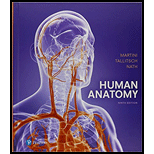
Concept explainers
Active sites on actin become available for binding when
(a) calcium binds to troponin.
(b) troponin binds to tropomyosin.
(c) calcium binds to tropomyosin.
(d) actin binds to troponin.
Introduction:
Muscles are made up of two main protein filaments namely, a thick filament that is made up of a protein called myosin and a thin filament that is composed of a protein known as actin. When these two filaments crossover one another in a row of repetitive events then muscle contraction takes place.
Answer to Problem 1RFT
Correct answer:
Thin filament consists of regulatory proteins called tropomyosin and troponin and the calcium ions binds with the troponin.
Explanation of Solution
Explanation for the correct answer:
Option (a) is given as calcium binds to troponin. The muscle contraction takes place in a series of steps. The cycle starts with electrical events in the sarcolemma. This accelerates the generation of calcium ions from the cisternae of the sarcoplasmic reticulum. The calcium ions then enter the zone of overlap. The next step involves binding of these calcium ions to troponin in the complex of troponin-tropomyosin. This alters the position and rolls the tropomyosin molecule away from the active sites present on the actin. This makes the active sites exposed for the formation of cross-bridges. Hence option (a) is correct.
Explanation for the incorrect answers:
Option (b) is given as troponin binds to tropomyosin. Troponin binds to the troponin-tropomyosin complex and rolls away from the tropomyosin complex. So, it is a wrong answer.
Option (c) is given as calcium binds to tropomyosin. Calcium binds to the troponin molecule instead of tropomyosin molecule. So, it is a wrong answer.
Option (d) is given as actin binds to troponin. Troponin binds to the calcium and makes actin sites exposed. So, it is a wrong answer.
Hence, option (b), (c) and (d) are incorrect.
Therefore, it can be concluded that calcium ions bind to the troponin and this troponin then binds to the troponin-tropomyosin complex, making active sites exposed during muscle contractions.
Want to see more full solutions like this?
Chapter 9 Solutions
Pearson eText Human Anatomy -- Instant Access (Pearson+)
- Noggin mutation: The mouse, one of the phenotypic consequences of Noggin mutationis mispatterning of the spinal cord, in the posterior region of the mouse embryo, suchthat in the hindlimb region the more ventral fates are lost, and the dorsal Pax3 domain isexpanded. (this experiment is not in the lectures).a. Hypothesis for why: What would be your hypothesis for why the ventral fatesare lost and dorsal fates expanded? Include in your answer the words notochord,BMP, SHH and either (or both of) surface ectoderm or lateral plate mesodermarrow_forwardNot part of a graded assignment, from a past midtermarrow_forwardNot part of a graded assignment, from a past midtermarrow_forward
- please helparrow_forwardWhat does the heavy dark line along collecting duct tell us about water reabsorption in this individual at this time? What does the heavy dark line along collecting duct tell us about ADH secretion in this individual at this time?arrow_forwardBiology grade 10 study guidearrow_forward
 Human Biology (MindTap Course List)BiologyISBN:9781305112100Author:Cecie Starr, Beverly McMillanPublisher:Cengage Learning
Human Biology (MindTap Course List)BiologyISBN:9781305112100Author:Cecie Starr, Beverly McMillanPublisher:Cengage Learning Anatomy & PhysiologyBiologyISBN:9781938168130Author:Kelly A. Young, James A. Wise, Peter DeSaix, Dean H. Kruse, Brandon Poe, Eddie Johnson, Jody E. Johnson, Oksana Korol, J. Gordon Betts, Mark WomblePublisher:OpenStax College
Anatomy & PhysiologyBiologyISBN:9781938168130Author:Kelly A. Young, James A. Wise, Peter DeSaix, Dean H. Kruse, Brandon Poe, Eddie Johnson, Jody E. Johnson, Oksana Korol, J. Gordon Betts, Mark WomblePublisher:OpenStax College Human Physiology: From Cells to Systems (MindTap ...BiologyISBN:9781285866932Author:Lauralee SherwoodPublisher:Cengage Learning
Human Physiology: From Cells to Systems (MindTap ...BiologyISBN:9781285866932Author:Lauralee SherwoodPublisher:Cengage Learning
 Biology 2eBiologyISBN:9781947172517Author:Matthew Douglas, Jung Choi, Mary Ann ClarkPublisher:OpenStax
Biology 2eBiologyISBN:9781947172517Author:Matthew Douglas, Jung Choi, Mary Ann ClarkPublisher:OpenStax Biology: The Dynamic Science (MindTap Course List)BiologyISBN:9781305389892Author:Peter J. Russell, Paul E. Hertz, Beverly McMillanPublisher:Cengage Learning
Biology: The Dynamic Science (MindTap Course List)BiologyISBN:9781305389892Author:Peter J. Russell, Paul E. Hertz, Beverly McMillanPublisher:Cengage Learning





